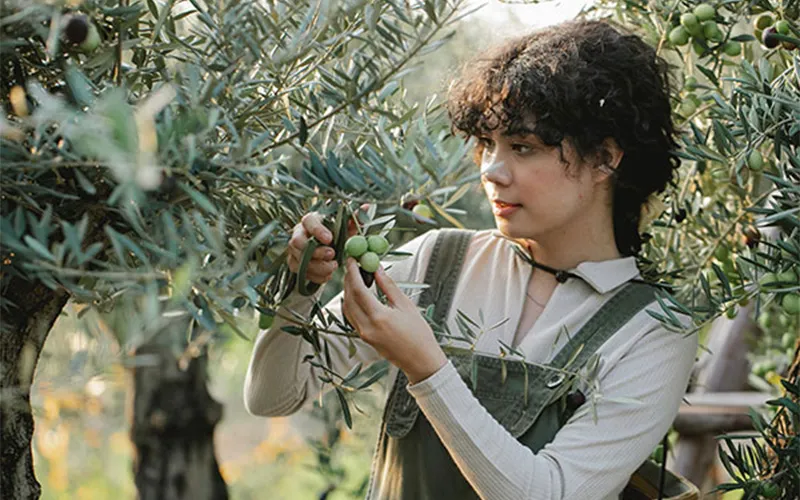At TOMA & COE, we love sharing the secrets of Spain’s rich culinary traditions with travellers, and no food embodies the essence of Spanish gastronomy more than olive oil.

The olive harvest is under way in southern Spain and, depending on the location and particular fruits, can last until February. Our very own Manni Coe has harvested his olives, resulting in 90+litres of EVOO – Extra Virgin Olive Oil.
But what is the difference between Extra Virgin Olive Oil, Virgin Olive Oil and the rest? Let’s find out…
Spain is the world’s largest producer of olive oil, with an incredible variety of types, each offering unique flavours, textures, and uses. Whether you’re a foodie looking to expand your knowledge, or a curious traveller interested in Spain’s culinary delights, understanding the different types of olive oil is key to appreciating the nuances of the country’s cuisine.
Extra Virgin Olive Oil (EVOO): The Gold Standard

When people think of the best olive oil, Extra Virgin Olive Oil often comes to mind. Considered the highest quality olive oil, EVOO is made from the first cold press of the olives and has no chemical treatment or refining. It must meet strict standards in terms of flavour, acidity (less than 0.8%), and aroma to earn the label of “extra virgin.”
Regions like Andalucía and Castilla-La Mancha are well known for their exceptional extra virgin olive oils, with varieties from Picual, Hojiblanca, and Arbequina olives being particularly popular.
Flavour
It’s packed with fresh, fruity, and sometimes bitter flavours. EVOO often has a complex taste, including notes of green tomatoes, apples, artichokes, or almonds.
Viscosity
It tends to have a thick, rich texture with a smooth finish.
Best Use
Drizzle it over salads, grilled vegetables, or bread, or enjoy it on its own as a dipping oil. EVOO is best appreciated when it is uncooked to savour its pure flavour.
Virgin Olive Oil: A Step Down but still Delicious
Virgin Olive Oil is also produced from the first cold pressing, but its quality is slightly lower than EVOO. The key difference lies in its acidity, which can be up to 2%, and the flavour profile, which may have slight defects.
Flavour
Virgin olive oil has a milder taste compared to EVOO, with less intensity. The flavours can still be fruity, but they are subtler and not as complex.
Viscosity
The viscosity is still quite smooth, though not as rich or dense as extra virgin.
Best Use
It can be used for cooking at low to medium temperatures, but it’s still good for dressings and dips where a more delicate flavour is preferred.
Refined Olive Oil: Smooth and Versatile
Refined Olive Oil undergoes a process that strips it of impurities, producing an oil with a more neutral taste and aroma. It’s made from lower-quality olives or oil that has been processed to remove off-flavours and acidity, resulting in a more generic product with less distinct characteristics.
Flavour
This oil has a light, almost flavourless profile, making it ideal for those who don’t want the strong, fruity taste of virgin or extra virgin varieties.
Viscosity
Refined olive oil tends to be thinner and lighter in texture, making it easier to use in a range of dishes.
Best Use
Because it has a higher smoke point, it’s often used for frying or sautéing, where the flavour of the oil itself is less important than its cooking properties.
Pomace Olive Oil: A Cooking Staple
Pomace Olive Oil is made from the remaining pulp, pits, and skin of the olives after the first press. It undergoes a refining process to make it edible, resulting in an oil that’s suitable for high-temperature cooking.
Flavour
Almost neutral in taste, pomace oil won’t add much flavour to your dish, but it also won’t overpower other ingredients.
Viscosity
It’s lighter and thinner than virgin or extra virgin oils.
Best Use
Ideal for frying and baking, pomace oil is popular in professional kitchens where large amounts of oil are needed for cooking, and taste isn’t the primary focus.
Olive Varieties and their Unique Characteristics

Spain produces a wide range of olive varieties, each lending its own unique flavour, texture, and colour to the oil. These are the primary olives used for oil.
Picual
Grown primarily in Andalucía, Picual olives produce an oil that is bold, slightly bitter, and peppery. It has a robust, intense flavour with notes of green olives, figs, and tomatoes. Picual oil has a high concentration of antioxidants, making it both healthy and long-lasting.
Arbequina
Found mainly in Catalonia and Aragón, Arbequina olive oil is much milder and sweeter than Picual. It’s light and fruity, with a buttery texture and notes of apple, almond, and banana. Arbequina oil is often preferred by those who enjoy a smoother, more delicate olive oil.
Hojiblanca
Another Andalucian variety, Hojiblanca olive oil is balanced and versatile, with both sweet and bitter notes. Its fruity profile includes hints of herbs, apple, and even a slight spiciness on the finish. This makes it ideal for both drizzling and cooking.
Cornicabra
Mainly from the Castilla-La Mancha region, Cornicabra oil is distinguished by its green colour and balanced taste, with a blend of fruity and slightly peppery notes. It has a medium-thick texture and works well in sauces and marinades.
The Importance of Viscosity and Texture

The texture and viscosity of olive oil vary depending on the type of olives, the production method, and the oil’s freshness. EVOO is typically the thickest, offering a luxurious, smooth mouthfeel, while pomace and refined oils are thinner, making them easier to use in cooking.
The viscosity affects how the oil coats the palate, which is why extra virgin oils are often prized for finishing dishes, offering a rich, lingering aftertaste.
The different production processes:
Unfiltered olive oil: Contains small olive particles, offering a more intense flavour and cloudier colour. It is often found in high-quality olive oils.
Filtered olive oil: Undergoes a filtering process to remove solid particles, giving it a lighter colour and milder taste.
Cold-pressed olive oil: Extracted from the first pressing of olives without heat, preserving the oil’s full flavor and nutritional properties.
Cold “first pressed” olive oil: Similar to cold-pressed, but specifically from the initial extraction without heat.
Cold extraction olive oil: Made without any heat during extraction, ensuring the highest possible quality.
Choosing the right Olive Oil

The key to selecting the right olive oil lies in understanding its flavour profile and intended use. For raw applications like salad dressings, dips, or drizzling, a high-quality extra virgin olive oil will offer the best taste and texture. For cooking, where higher heat is involved, refined or pomace oil is a better choice due to its neutral flavour and high smoke point.
Whether you’re interested in discovering the best olive oil for your cooking needs or keen to experience an olive farm tour with us at TOMA & COE, exploring Spain’s olive oils is a journey into the heart of its culinary traditions.























